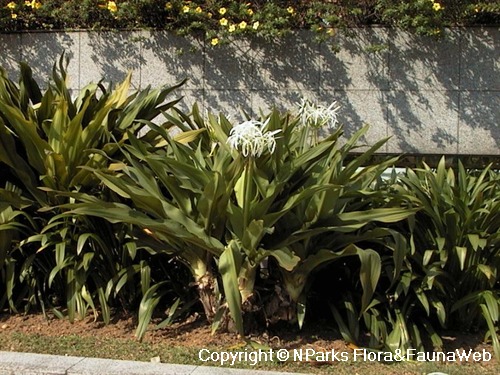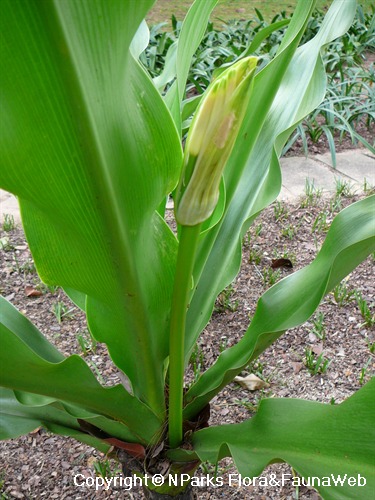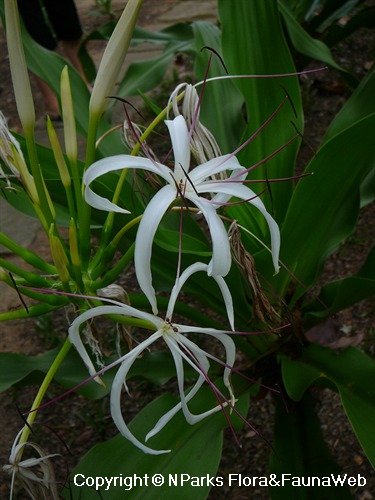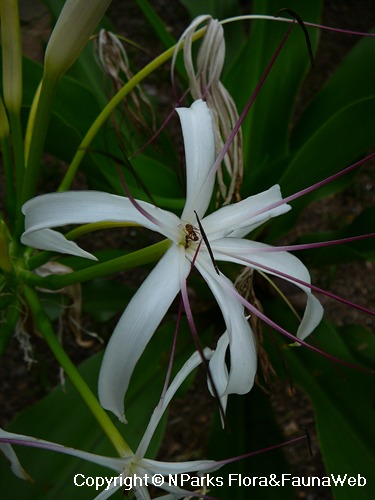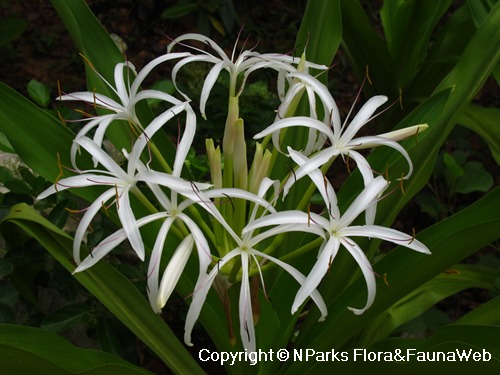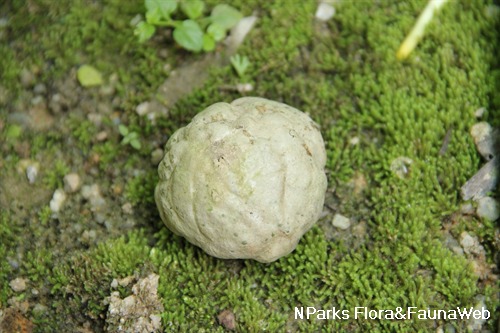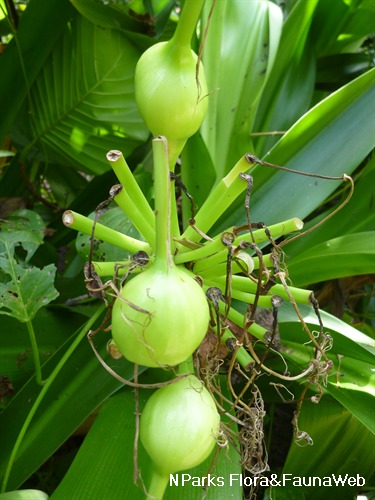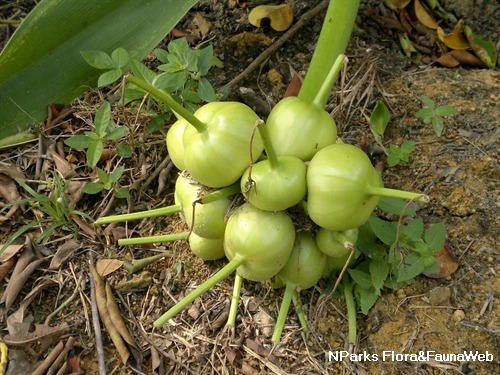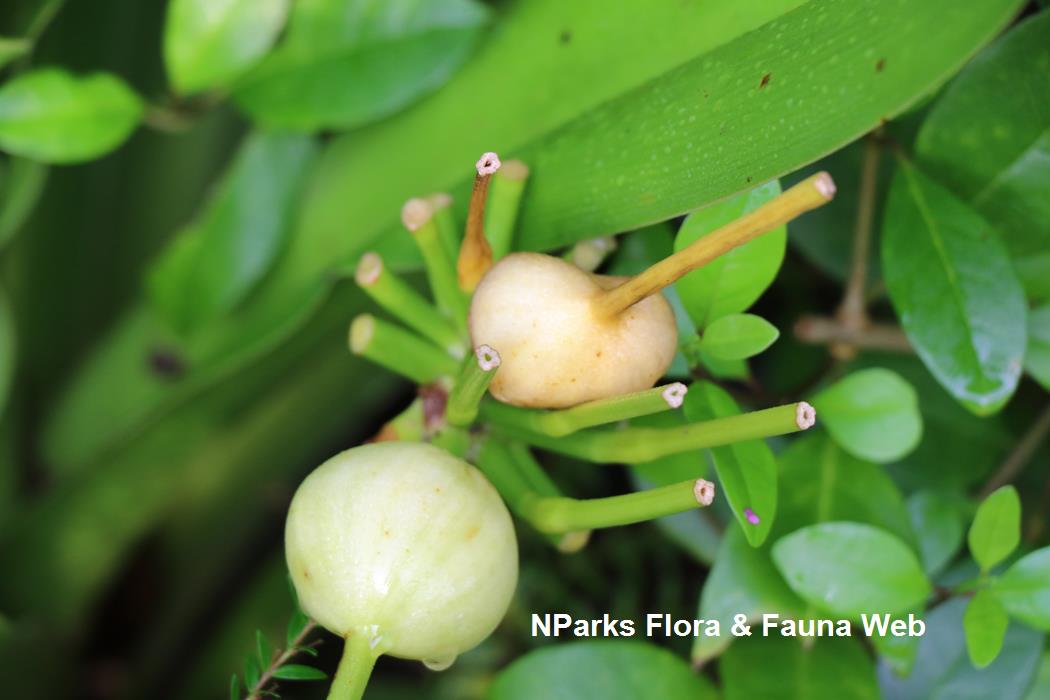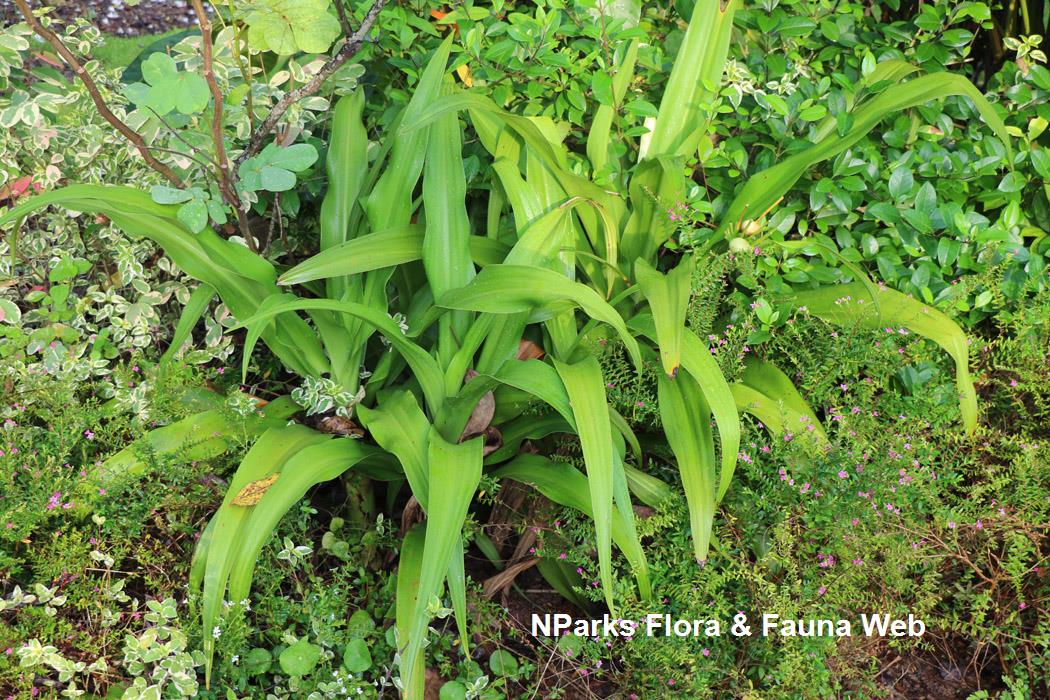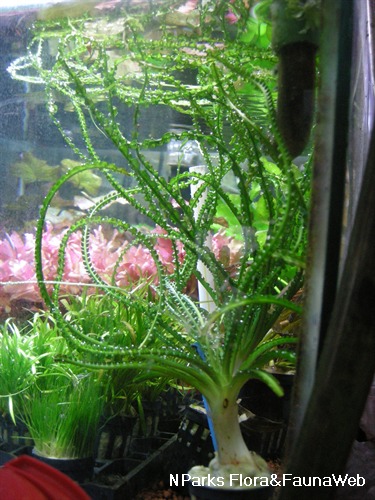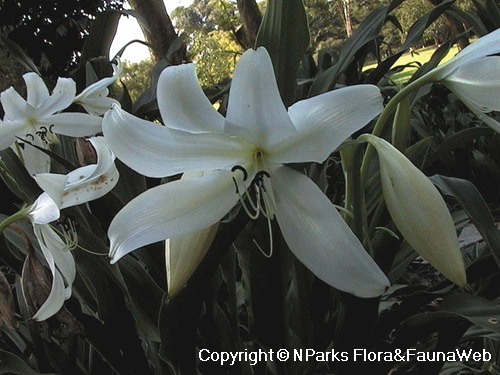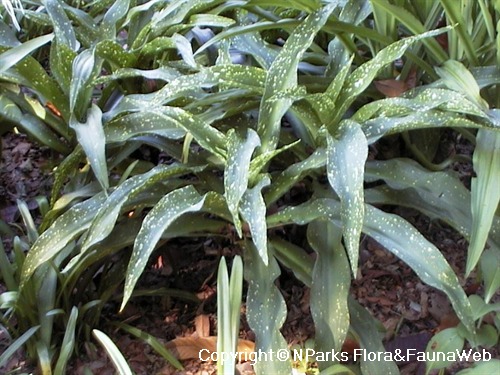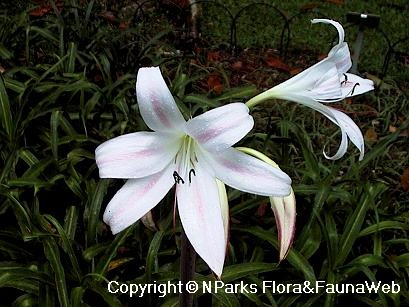
Back
Crinum asiaticum L.
| Family Name: | Amaryllidaceae |
| Synonyms: | Crinum northianum Baker |
| Common Name: | Seashore Lily, Poison Bulb, Bakung, Crinum Lily, Asiatic Poison Lily, Spider Lily, Seashore Crinum, Bawang Hutan, 文殊兰 |
Crinum asiaticum or Seashore Lily is a large bulbous herb, reaching up to 2 m tall. This native herb has long lance-shaped leaves with smooth to wavy leaf margins. Flowers have long sepals and petals produced in clusters of 10 - 50, often fragrant during night time. Seashore lilies are salt and heat tolerant therefore can be used along coastal areas and sites that require low maintenance.
Name
Classifications and Characteristics
| Plant Division | Angiosperms (Flowering Seed Plants) (Monocotyledon) |
|---|---|
| Plant Growth Form | Herbaceous Plant |
| Lifespan (in Singapore) | Perennial |
| Mode of Nutrition | Autotrophic |
| Maximum Height | 2 m |
| Maximum Plant Spread / Crown Width | 2.5 m |
Biogeography
| Native Distribution | Mascarenes to subtropical and tropical Asia (including Singapore) to the southwest Pacific. |
|---|---|
| Native Habitat | Terrestrial (Coastal Forest), Shoreline |
| Preferred Climate Zone | Tropical, Sub-Tropical / Monsoonal |
| Local Conservation Status | Native to Singapore (Critically Endangered (CR)) |
Description and Ethnobotany
| Growth Form | It is a large, bulb-bearing herbaceous plant that grow up to 2 m tall, with a rosette of leaves at the top of its stem. |
|---|---|
| Foliage | Its stalkless leaves have leaf blades that are lanceolate, light-green, 50-150 by 3-20 cm, and have prominent parallel veins, with many cross veins. |
| Flowers | Its flowers grow in clusters of 10-50, at the top of a long stalk. Its sepals and petals are lanceolate, white, and 6-12 by 0.5-1.2 cm. Flowers are fragrant at night. |
| Fruit | Its fleshy fruits are irregularly-rounded, 2.5-6.5 cm wide, and 1-5 seeded. Its seeds are 2-4.5 cm wide. |
| Habitat | It grows along the borders of coastal forests, mangrove forests, sandy shores, and water edges, at low altitudes. It occurs locally at Pulau Pawai. |
| Associated Fauna | It is the host-plant for the caterpillars of the moths, the lily borer or kew arches (Brithys crini), and the lily caterpillar moth (Spodoptera picta). |
| Taxonomy | This species used to be known as Bulbine asiatica, but that name is now a synonym. |
| Cultivation | It can be propagated by seed. |
| Etymology | Greek krinon, lily, Latin, asiaticum, from Asia, referring to the geographical distribution of this species. |
| Ethnobotanical Uses | Medicinal: The crushed leaves are used to wash piles. Mixed with honey, they are applied to wounds and abscesses. The leaves and bulbs can be used to induce vomiting, because they contain the alkaloid lycorine. The plant is used medicinally for treating breast infections and wounds, haemorrhoids and inflammation, as a diuretic, as a poultice for closed fractures, contusions, rheumatism and sprains, to aid getting rid of excess water from the body and for easing childbirth.
This information is not meant to be substituted for medical advice. Readers should always consult a medical professional before any remedy programme is initiated. Others: This species accumulates selenium, and could potentially be used to cleanse contaminated soil. |
Landscaping Features
| Landscaping | It is suitable for planting along streetscapes, parks, gardens, flower beds and coastal areas for its tolerance of hot and windy conditions, and its white showy flowers. |
|---|---|
| Desirable Plant Features | Ornamental Flowers, Ornamental Foliage, Fragrant (Flowers) (Night) |
| Landscape Uses | Coastal, General, Suitable for Roadsides, Parks & Gardens, Small Gardens, Flowerbed / Border |
Fauna, Pollination and Dispersal
| Fauna Pollination Dispersal Associated Fauna | Caterpillar Moth Food Plant |
|---|---|
| Pollination Method(s) | Biotic (Fauna) |
| Seed or Spore Dispersal | Abiotic |
Plant Care and Propagation
| Light Preference | Full Sun |
|---|---|
| Water Preference | Moderate Water |
| Rootzone Tolerance | Drought Tolerant, Moist Soils, Well-Drained Soils, Saline Soils / Salt Spray, Fertile Loamy Soils |
| Maintenance Requirements | Low |
| Pest(s) | Chewing Insects |
| Propagation Method | Seed |
| Propagation Method Remarks | Division of the bulbs |
Foliar
| Foliage Retention | Evergreen |
|---|---|
| Mature Foliage Colour(s) | Green - Light Green |
| Mature Foliage Texture(s) | Smooth |
| Foliar Type | Simple / Unifoliate |
| Foliar Arrangement Along Stem | Rosulate / Rosette |
| Foliar Attachment to Stem | Sessile |
| Foliar Shape(s) | Non-Palm Foliage (Lanceolate) |
| Foliar Venation | Parallel |
| Foliar Margin | Entire, Entire - Wavy / Undulate |
| Foliar Apex - Tip | Acute |
| Foliar Base | Truncate / Square |
| Leaf Area Index (LAI) for Green Plot Ratio | 3.5 (Shrub & Groundcover - Monocot) |
Floral (Angiosperm)
| Flower & Plant Sexuality | Bisexual Flowers |
| Flower Colour(s) | White |
|---|---|
| Flower Grouping | Cluster / Inflorescence |
| Flower Location | Terminal |
| Flower Symmetry | Radial |
| Individual Flower Shape | Tubular |
| Inflorescence Type | Umbel |
| Flower Size | 20 cm |
Fruit, Seed and Spore
| Mature Fruit Colour(s) | Green - Light Green |
|---|---|
| Mature Fruit Texture(s) | Glossy / Shiny |
| Fruit Classification | Simple Fruit |
| Fruit Type |
References
| References | Yong J, Tan PY, Nor Hafiz Hassan, Tan SN. 2010. A Selection of Plants for Greening of Waterways and Waterbodies in the Tropics. Singapore: Chung Printing . 480 pp. |
|---|
Image Repository
Others
| Master ID | 586 |
|---|---|
| Species ID | 1881 |
| Flora Disclaimer | The information in this website has been compiled from reliable sources, such as reference works on medicinal plants. It is not a substitute for medical advice or treatment and NParks does not purport to provide any medical advice. Readers should always consult his/her physician before using or consuming a plant for medicinal purposes. |

